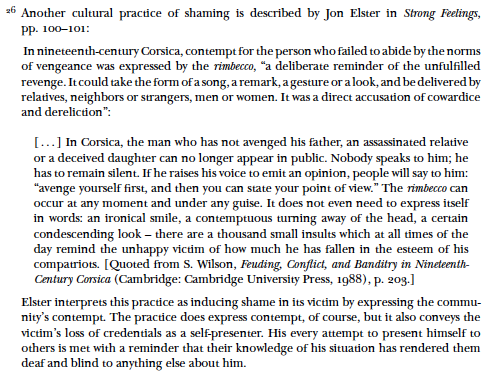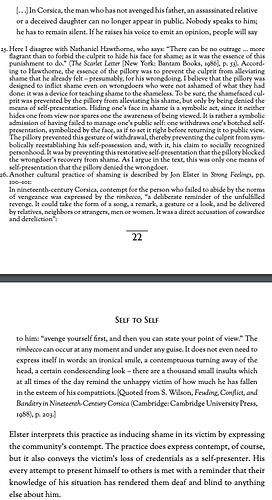I’m looking to accomplish a couple things inside auto-generated [footnote] tags in PDF exports. Lots of examples incoming! In these tags, I need to…
- Utilize a
<blockquote>tag (or, something similar that will mimic a blockquote’s formatting) - Delineate multiple paragraphs within a blockquote
I’m working on a straightforward, traditional monograph, exporting in Austen. There are a number of instances in the monograph where a footnote requires blockquotes. Here’s a screencap of an example footnote from an older iteration of the book (this is not the PB export, but what I need to achieve):
When attempting to wrap the blockquote (“[. . . ] In Corsica…”), in a <blockquote> tag, the export pops it both the quote and the following paragraph into the main body text:
[footnote]Another cultural practice of shaming is described by Jon Elster in <em>Strong Feelings</em>, pp. 100–101: In nineteenth-century Corsica, contempt for the person who failed to abide by the norms of vengeance was expressed by the <em>rimbecco</em>, “a deliberate reminder of the unfulfilled revenge. It could take the form of a song, a remark, a gesture or a look, and be delivered by relatives, neighbors or strangers, men or women. It was a direct accusation of cowardice and dereliction”: <blockquote>[. . .] In Corsica, the man who has not avenged his father, an assassinated relative or a deceived daughter can no longer appear in public. Nobody speaks to him; he has to remain silent. If he raises his voice to emit an opinion, people will say to him: “avenge yourself first, and then you can state your point of view.” The <em>rimbecco</em> can occur at any moment and under any guise. It does not even need to express itself in words: an ironical smile, a contemptuous turning away of the head, a certain condescending look – there are a thousand small insults which at all times of the day remind the unhappy victim of how much he has fallen in the esteem of his compatriots. [Quoted from S. Wilson, <em>Feuding, Conflict, and Banditry in Nineteenth-Century Corsica</em> (Cambridge: Cambridge University Press, 1988), p. 203.] </blockquote> Elster interprets this practice as inducing shame in its victim by expressing the community’s contempt. The practice does express contempt, of course, but it also conveys the victim’s loss of credentials as a self-presenter. His every attempt to present himself to others is met with a reminder that their knowledge of his situation has rendered them deaf and blind to anything else about him.[/footnote]
Any tips on how I can delineate both blockquotes and new paras inside the footnote tags?




